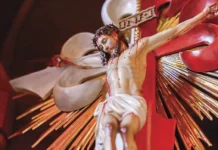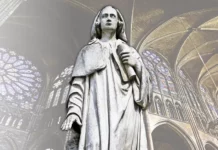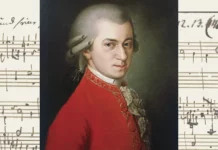In considering Mary’s life, we tend to think of her presence in Bethlehem, Nazareth or Calvary, leaving aside the period in which, deprived of the human presence of Jesus, She remained in His company through the consecrated Species.
I n founding the Congregation of the Blessed Sacrament in 1856, St. Peter Julian Eymard brought the cult of the Eucharist to the highest degree through its perpetual and solemn exposition. This is the originality of his foundation.
His zeal impelled him to strive and work hard to establish Perpetual Adoration in the very place where Christ instituted the Divine Sacrament, the Upper Room. But despite his efforts, he was unable to achieve this symbolic and ingenious goal.
As could not be otherwise, this Saint was also a great devotee of the Blessed Virgin Mary, who inspired him to found his providential congregation. He wrote, for the benefit of his spiritual children, a brief Marian-Eucharistic meditation, summarized by one of his disciples, which will be of interest to all faithful adorers of the Eucharist.
Model for Eucharistic souls
“‘Our Lady of the Blessed Sacrament is the new name for something very old’ […]. All the mysteries of the life of the Mother of God are rightly venerated. Contemplative souls have an example in the life of Mary at Nazareth, just as desolate hearts find consolation in the Sorrowful Virgin. There is a grace in all the actions of the Blessed Virgin that sweetly leads us to honour and imitate them, each according to our own vocation.
“Now, Mary lived more than fifteen years after the Ascension of her Divine Son. What occupations filled those long days of exile, and what grace marked this important period of our Mother’s life? The Book of the Acts of the Apostles answers us very clearly. In it we read that the first Christians lived in peace, in union and in the most ardent charity […], persevering in the breaking of bread (cf. Acts 2:42).
“To live of the Eucharist and for the Eucharist, to gather around the tabernacle to sing hymns and spiritual songs: this is the distinctive character of the early Church. The Holy Spirit recorded this in the sublime ecclesiastical history written by St. Luke; it was also the summary of the last years of the Blessed Virgin, who reencountered in the adorable Host the blessed Fruit of her womb, and in the life of union with Our Lord in the tabernacle, the happy times of Bethlehem and Nazareth. Oh, yes! It is Mary above all who persevered in the breaking of the bread.
“O Eucharistic souls, who wish to live for the Blessed Sacrament, who have made the Eucharist the centre of your lives and its service your only labour, Mary is your model; her life is your grace. Persevere, as She did, in the breaking of the bread.”1
Living with Jesus in the consecrated Species
In fact, when we consider Mary’s life, we tend to think of her presence in Bethlehem, at Nazareth or on Calvary, leaving aside the period when, deprived of the human presence of Jesus – as She was until the Ascension – She remained in His company through the consecrated Species which beat uninterruptedly in her Heart, and which was renewed at each Communion.
A pious ancient author, Bernardine of Paris,2 affirms that Jesus, in instituting the Eucharist, had in mind especially His Mother, so that the most exalted of His works might be received by the noblest of His creatures.
Only Mary Most Holy preserved complete faith while Jesus was in the tomb. After the Resurrection, She encouraged the disciples, kept them united and hopeful, facilitated the coming of the Holy Spirit, instructed the Apostles with her testimony, her counsels and her accounts of the life of her Divine Son.
Who other than She could have narrated to St. Luke the episodes of Jesus’ childhood recounted in his Gospel? And how many confidences did St. John receive from Her whom Christ on the Cross entrusted to his care? Mary is rightly called Mother of the Church, because from its very beginning She provide it with example, strength and instruction, and in Heaven She continues to exercise this mission to this day!
Ever growing fervour under Mary’s protection

Florence (Italy)
The Church is always growing in holiness over the course of history, since the sins of her members cannot disfigure her in her substance. Christ “loved the Church and gave himself up for her, that He might sanctify her, having cleansed her by the washing of water with the word, that He might present the Church to himself in splendour, without spot or wrinkle or any such thing, that she might be holy and without blemish” (Eph 5:25-27). Through the power of the Eucharist and under Mary’s protection, let it not be thought that the Church merely “survives” the various crises she has to undergo. She is constantly renewed and making progress!
The spreading of devotion to the Blessed Sacrament is one aspect of this continuous progress. While it is true that various churches have been closed recently, and some have even been desecrated, it is no less true that Eucharistic fervour and thirst have been intensified in diverse places.
For example, in many chapels of the Heralds of the Gospel, Adoration of the Blessed Sacrament has been taking place uninterruptedly for years.
The eternal reward for adorers of the Eucharistic Jesus
Such a refulgent reality does not shine before the eyes of the paganized world, but rather before the throne of the Most High. How many benefits these acts of adoration produce, and how many misfortunes they avert! Prayer at the feet of the Blessed Sacrament obtains remarkable graces.
The many hours that St. Peter Julian Eymard spent close to the Blessed Sacrament – at the altar, near the tabernacle or before the monstrance – earned him the reward of seeing without veils the God he adored hidden in the Eucharist, and of contemplating Our Lady of the Blessed Sacrament, his Mother. For to enjoy this heavenly company forever is the marvellous eternal destiny of the adorers of all ages. ◊
Transcribed, with abridgements,
from the message written to the
World Federation of the Eucharistic Works of the Church, of which the
author is a member of the executive council
Notes
1 TESNIÈRE, SSS, Albert. Le prête de l’Eucharistie ou Le Bienheureux Pierre-Julien Eymard. 9.ed. Lille: Desclée de Brouwer, 1926, p.166-168.
2 Cf. BERNARDINE OF PARIS. La Communion de Marie, Mère de Dieu. Paris: Jacques Lecoffre, 1860, p.18.







